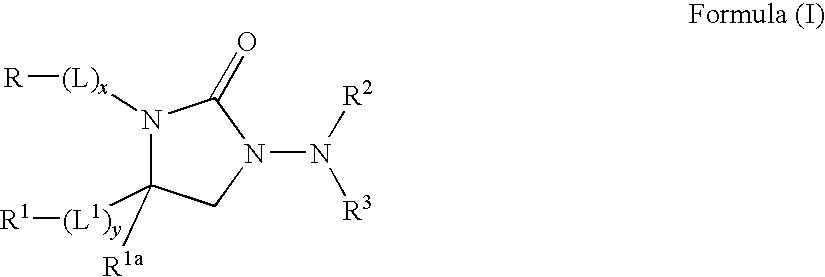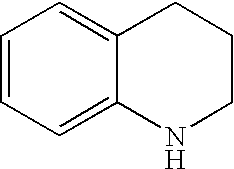Kv1.5 potassium channel inhibitors
a potassium channel inhibitor and potassium channel technology, applied in the direction of biocide, drug composition, extracellular fluid disorder, etc., can solve the problems of precipitating the occurrence of life-threatening ventricular arrhythmias, and achieve the effect of inhibiting the function of kv1.5 potassium channel
- Summary
- Abstract
- Description
- Claims
- Application Information
AI Technical Summary
Benefits of technology
Problems solved by technology
Method used
Image
Examples
example 1
[0187]Compound 1: 1-Amino-3-[2-(4-methoxyphenyl)ethyl]-4-(3,4-dimethylphenyl)-2-imidazolidinone
[0188]Step A: Preparation of 3,4-dimethyl-[(1E)-2-nitroethenyl]benzene: A solution of 3,4-dimethylbenzaldehyde (20 mL, 0.15 mol), ammonium acetate (12.5 g, 0.16 mol), glacial acetic acid (65 mL), nitromethane (34 mL, 0.63 mol), and acetic anhydride (3.0 mL, 0.032 mol) is refluxed for 2 hours. The reaction is concentrated to an oil, then dichloromethane (100 mL) is added, and the solution is washed with water (2×) and brine. The organic phase is dried (MgSO4), and concentrated to a dark green solid. This material is re-crystallized (treated with Darco) from 50% cyclohexane / hexanes to afford 17.6 g (66% yield) of the desired compound. 1H NMR (CDCl3) δ 8.08 (dd, J=2.4 Hz, 13.5 Hz, 1H), 7.61 (dd, J=2.4 Hz, 13.5 Hz, 1H), 7.31-7.36 (m, 2H), 7.25 (d, J=7.8 Hz, 1H), 2.36 (s, 3H), 2.35 (s, 3H); MS 329 (MH+).
[0189]Step B: Preparation of N-[2-(4-methoxyphenyl)ethyl]-3,4-dimethyl-(α-nitromethyl)-benze...
example 2
N1-[2-(4-methoxyphenyl)ethyl]-1-(4-methoxyphenyl)-1,2-ethanediamine
[0194]Preparation of (4-methoxyphenyl)-trimethylsilanyloxyacetonitrile: To a solution of 4-methoxybenzaldehyde (1 mL, 8.2 mmol) and trimethylsilyl cyanide (1.3 mL, 10.25 mmol) is added zinc iodide (50 mg, 0.15 mmol). The resulting exothermic reaction is controlled using an ice-bath. The temperature is maintained below 65° C. The reaction is allowed to cool and the crude material is used without isolation.
[0195]Preparation of (4-methoxyphenyl)-[2-(4-methoxyphenyl)ethylamino]acetonitrile: 4-Methoxyphenethylamine (1.2 mL, 8.2 mmol) and methanol (0.5 mL) are added to the crude material obtained above. The solution is heated to 125° C. for 15 minutes in a microwave reaction vessel after which the solution is concentrated in vacuo and the crude product obtained is used without further purification.
[0196]Preparation of N1-[2-(4-methoxyphenyl)ethyl]-1-(4-methoxyphenyl)-1,2-ethanediamine: The crude (4-methoxyphenyl)-[2-(4-met...
example 3
[0204]Compound 7: 1-(Methylsulfonylamino)-3-[2-(4-methoxyphenyl)ethyl]-4-(3,4-dimethylphenyl)-2-imidazolidinone.
[0205]Preparation of 1-(methylsulfonylamino)-3-[2-(4-methoxyphenyl)ethyl]-4-(3,4-dimethylphenyl)-2-imidazolidinone: A solution of 1-amino-3-[2-(4-methoxyphenyl)-ethyl]-4-(3,4-dimethylphenyl)-2-imidazolidinone hydrochloride (300 mg, 0.80 mmol) in dichloromethane (3.0 mL) and Hunig's base (0.31 mL, 1.8 mmol) is cooled in an ice bath and methanesulfonyl chloride (0.068 mL, 0.88 mmol) is added dropwise. The reaction is stirred cold for 45 minutes and washed with 0.1 N HCl (2×) and H2O. The organic phase is dried (Na2SO4), and concentrated to a white foam. The crude material is purified over silica (1.5% MeOH / dichloromethane) to afford 161 mg (48% yield) of the desired compound. 1H NMR (CDCl3) δ 7.17 (d, J=8.1 Hz, 1H), 7.07 (m, 2H), 7.00 (m, 2H), 6.85 (m, 3H), 4.45 (t, J=8.1 Hz, 1H), 3.96 (t, J=8.1 Hz, 1H), 3.81 (s, 3H), 3.74 (m, 1H), 3.33 (t, J=8.4 Hz, 1H), 3.06 (s, 3H), 2.97 ...
PUM
 Login to View More
Login to View More Abstract
Description
Claims
Application Information
 Login to View More
Login to View More - R&D
- Intellectual Property
- Life Sciences
- Materials
- Tech Scout
- Unparalleled Data Quality
- Higher Quality Content
- 60% Fewer Hallucinations
Browse by: Latest US Patents, China's latest patents, Technical Efficacy Thesaurus, Application Domain, Technology Topic, Popular Technical Reports.
© 2025 PatSnap. All rights reserved.Legal|Privacy policy|Modern Slavery Act Transparency Statement|Sitemap|About US| Contact US: help@patsnap.com



